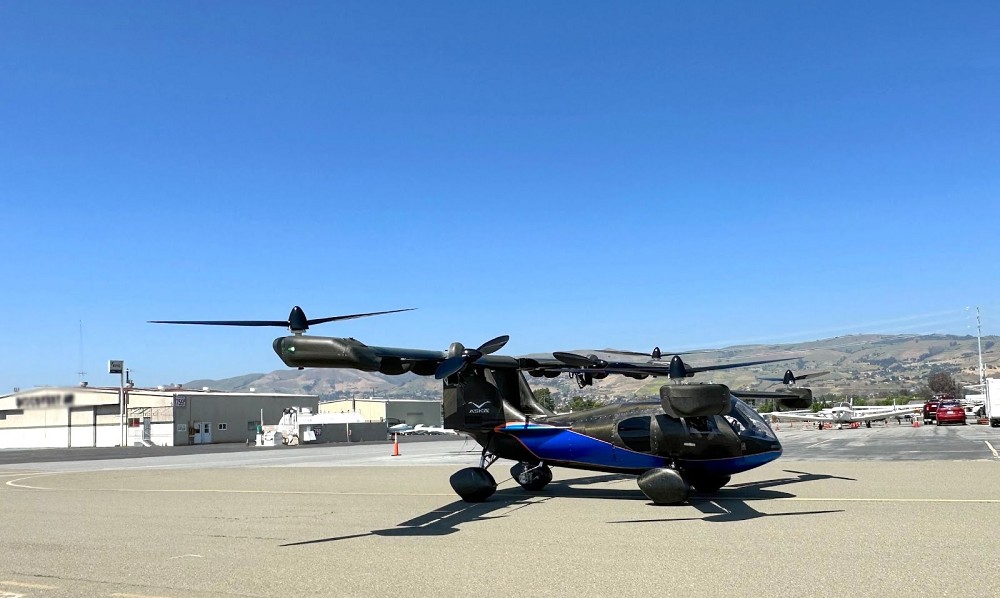Aska Completes First Test Flight of Its ‘Street Legal eVTOL’

We’re still a few decades away from 2062, but Jetsonian flying cars are already taking to the U.S. skies.
Aska, the Mountain View, California-based startup developing a car, electric vertical takeoff and landing (eVTOL), fixed-wing glider amalgamation, this week completed the first airborne tests of its full-scale A5 flying car prototype. The successful test run comes about a month after the company received the green light for flight testing from the FAA.
The full-scale prototype, about the size of an SUV when in driving configuration, has not yet flown on its fixed wings. But tethered to the ground at a California airfield, the A5 this week took off with hovered thrust for the first time.
Founded by husband and wife duo Guy and Maki Kaplinsky in 2018, Aska unveiled its first A5 prototype—billed as a “street legal eVTOL”—just one year later. Now, the company is looking to certify the vehicle, which is expected to cost $789,000, ahead of a planned 2026 launch.
“It was an incredible feeling of accomplishment for the team to reach this new milestone,” said Guy Kaplinsky, CEO of Aska. “This moment represents a giant leap for the aviation and automotive industries. Having accomplished the first series of hover flight testing as well as driving testing, Aska is a pioneer in the field of electric flying cars with VTOL capabilities.”
The Design
The Aska A5 was first unveiled in January before a crowd at CES 2023 in Las Vegas. Designed to carry three passengers and a pilot over a distance of up to 250 sm (217 nm) at 130 knots, the “drive-and-fly” vehicle isn’t the prettiest. But it’s packed with functionality.
On the road, its rounded cabin sits atop four wheels, with an array of wings and rotors folded on top. In this configuration, the A5 is about the size of an SUV and can fit in a standard parking spot, but early models will be limited to local roads and last-mile transport. Before takeoff, the wings and rotors unfold, transforming the vehicle into a small airplane.

But for the flying car skeptics out there, the A5’s greatest advantage is its malleability.
Not only can the vehicle drive like a car and fly like an airplane—it can also take off like a helicopter. Unlike rival Alef Aeronautics’ Model A, which is expected to take off directly from the road, Aska designed the A5 to make use of existing infrastructure, including helipads and vertiports.
With its six independent motors, the vehicle can lift off vertically, like the air taxis being developed by Joby Aviation, Archer Aviation, and others. But with in-wheel motors, aerodynamic wings, and the blown-lift thrust of its propellers, it can also conduct short takeoff and landing (STOL) operations from a runway.
“We are working with local airports in the [San Francisco] Bay Area to test and confirm our concept of operations—they open the gate, Aska A5 drives in as a car, drives/taxis to the helipad or runway, transforms into the flight mode, and can take off,” explained Maki Kaplinsky, chair and COO of Aska.

Aska expects the A5 to make use of other infrastructure too. The vehicle runs primarily on lithium-ion batteries that can be juiced up at a standard electric vehicle charging station. But it also features a range extender that charges the batteries in flight, which can be fueled with premium automobile gasoline (mogas) from any gas station.
Initially, the A5 will be piloted, but Guy Kaplinsky predicted it may fly autonomously as soon as 2030. Before then, Aska plans to lease it to pilots and launch a flying car rideshare service.
What’s Next?
Witnessing the A5’s maiden flight was probably an overwhelmingly exciting moment for the Aska team. But above all, the test represented the next step toward FAA type certification.
“This first liftoff was a true accomplishment and years of engineering design and analysis became a reality,” said Maki Kaplinsky. “We are closely working with the FAA to ensure continued excellent progress with our flight testing. We will continue the optimization of hovering and VTOL. The next phase will be working toward transition into cruise and STOL.”
This week’s flights do not count towards certification. But without them, Aska won’t be able to get to the flights that do.
The A5 first hit the streets in 2022, moving to public roads in the Silicon Valley area earlier this year after receiving permission from the California Department of Motor Vehicles. Already, it’s driven more than 300 miles.
In June, the vehicle obtained a certificate of authorization and special airworthiness certificate from the FAA, becoming one of the first flying car designs to do so. Now, Aska is eyeing a G-1 certification basis, the same criteria awarded to Joby, Archer, and Lilium in the past 12 months.
Aska opened preorder reservations for the A5 in 2021. Prospective customers can pay $5,000 for a position on the queue, and according to the company, those reservations so far would net it $50 million if they were realized today. At $789,000 per vehicle, that equates to around 63 preorders.
For full Article please see here:https://www.flyingmag.com/aska-completes-first-test-flight-of-its-street-legal-evtol/

